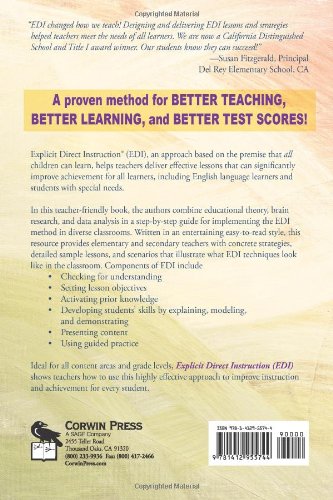Sobre nosotros
Servicios al cliente
Atención al cliente
Acceso Regional
Legales y políticas
Obtén la aplicación

Apunta tu cámara para descargar la aplicación
Copyright © 2024 Desertcart Holdings Limited




Explicit Direct Instruction (EDI): The Power of the Well-Crafted, Well-Taught Lesson
L**!
I absolutely LOVE this book
I absolutely LOVE this book! I have been reading two books on Explicit Instruction. They are both good, but this one tells you HOW and WHY. It is very explicit in teaching how to craft and deliver any concept or skill using direct instruction. I teach a classroom of students who are below grade level and after trying all kinds of differentiation in math, I found this. I have been trying it on and I am amazed at how engaged the students are, and how they are starting to pick up AND REMEMBER the concepts and skills.
A**R
The Bible for all teaching practitioners
All too often the latest fad in education crosses the pond from the USA and the methodologies are not validated or verified in a UK setting. This book uses tried and tested methodologies and puts the contents in an easily accessible format. There is no excuse for leaving any child behind using this format unless the teacher is distracted from their primary role, which is to teach, and not becoming data analysists.
L**N
Used in our professional development
Used in our fall professinal development. Great info.
J**N
Very useful but focused on traditional education approaches
John Hollingsworth and Silvia Ybarra are a husband and wife team that owns a company, DataWORKS, which provides educational services. In Explicit Direct Instruction they provide information about their education model by that name. I have two problems with this book. First of all it is largely an infomercial for their company and educational model. More substantially, EDI is designed for the traditional education approach of teacher-centered, knowledge-based learning. The authors state that the best way to convey information to students is to tell them directly and clearly. That may be so, but modern education needs to be about more than providing knowledge and a more student-centered, activity-based approach involving skills development is needed. Moreover the authors state that learning objectives should be based on state standards—what the students need to know to pass state assessment exams. Teaching to the test is another flaw in the current system of education in the United States.That said, the authors do provide a clear method for teaching any subject and any grade and some valuable ideas for teachers and educators. Their model is presented pictorially on page seven in a circle. The first segments, termed “preparation” include defining learning objectives and activating prior knowledge. They suggest that teachers should constantly check for understanding (CFU) and do so by randomly calling on students, not by selecting students who raise their hands. They also suggest an approach they label as “TAPPLE” which stands for Teach first, ask a question, pause, pick a non-volunteer, listen carefully to the student’s answer, and give effective feedback.The second section involves the presentation of the lesson and is divided into five parts including explaining the concept of the lesson, stressing the importance of the lesson, teaching the skills needed, engaging in guided practice, and closure, engaging in a final check. The third section is labeled “independent work” and includes independent practice in which the students work by themselves in the classroom, homework, which they do after school, periodic review and assessment.All of these sections are clearly explained in detail with numerous examples. This book, then, can be quite valuable to a classroom teacher even one who does not strictly follow the traditional teaching approach. People interested in education can also benefit from reading about such a well thought out method.
T**Y
Good ideas, but.......
There are some great ideas in this book, and they are generally well presented. They do mention the name of their company entirely too much. All of the examples and conversations they site are just a little too perfect. Please God, not more acronyms.
Trustpilot
Hace 2 semanas
Hace 2 semanas